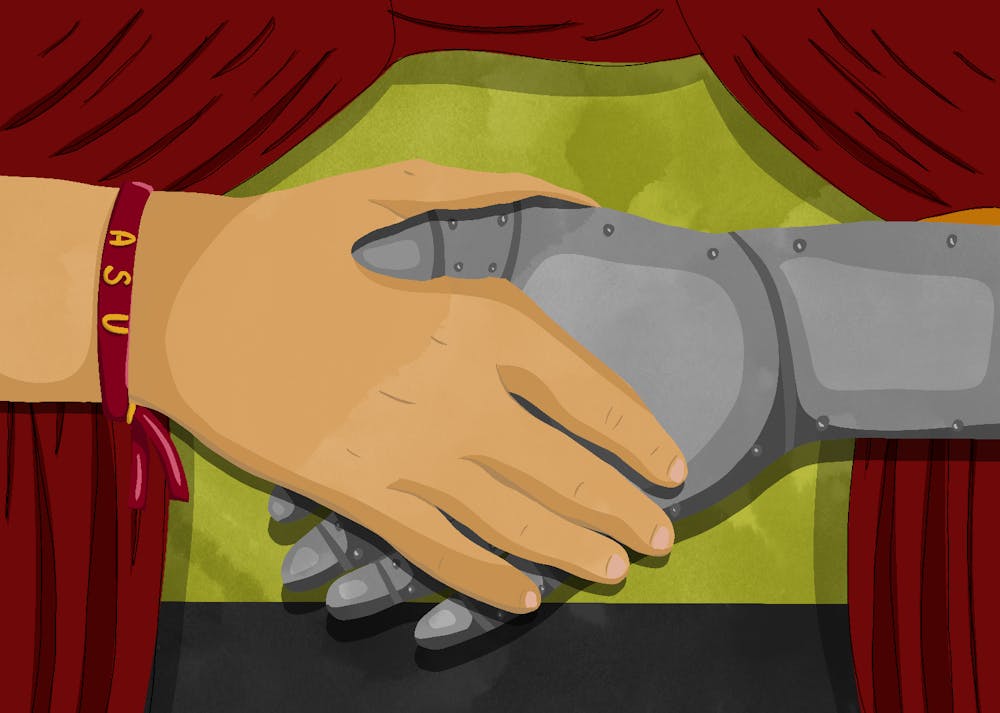In January 2024 ASU became the first higher education institution to partner with OpenAI, the company behind ChatGPT. This opens the gates for new learning and research opportunities across the University.
With a comprehensive design and arts institution containing programs in dance, theater, music, fashion, film and design, ASU faculty are trying to picture how the new partnership will impact the most creative classrooms on campus.
Traditionally, discussions surrounding artificial intelligence have often centered on technological and scientific domains, but as AI enters workplaces across the nation, creative professionals such as film writers and designers have begun to wrestle with technology's implications.
READ MORE: Charting ASU's future: Navigating OpenAI's first partnership in higher education
Though it is murky what the Herberger Institute for Design and the Arts students will gain from the partnership, OpenAI's step into the University setting underscores the vital role of AI in fostering innovation and creativity across all disciplines.
"I don't know if there's really any benefit for students or for faculty at this point," said Shawn Lawson, a program director and professor at the School of Art. "Because unless you go to Open AI and make your own account and wait for them to approve it, you don't really have any access to do anything with it."
According to ASU's artificial intelligence page, currently access to ChatGPT Enterprise through the partnership is given to faculty based on proposals. A system for students to create an account independently is not yet available.
Jorge Costa, an assistant professor at the School of Music, Dance and Theater who teaches classes in sound engineering and music production, said it's early to tell the benefits and pitfalls of the partnership.
Art departments within ASU have greeted this collaboration with a mixture of curiosity and enthusiasm. The prospect of integrating AI into artistic processes opens up a wealth of possibilities, challenging conventional notions of creativity and expression.
"I think if we figure out a way to transform AI into a collaboration tool, into a tool that might get us started when we're having trouble getting started, or get us through a creative block, it's going to be really positive," Costa said.
One area where ChatGPT Enterprise shows particular promise is in generating novel ideas and sparking inspiration. Some faculty already experiment with other AI tools during their own creative processes.
Costa said that he recently acquired an AI beat maker, a tool that records 15-second snippets of sounds on your phone and transforms them into individual samples, creating rhythmic patterns.
He recorded hitting different parts of his coffee machine with a metal tube, producing high-pitched noises. After some randomization, the beat maker created a loop which he used in part of a song he was producing with a group of artists.
As an experiment, he and a partner artist used ChatGPT to generate ideas for song lyrics.
"It didn't really give us great lyrics," Costa said. "It gave us great ideas to start lyrics."
Luis Angarita, a program head and associate professor of industrial design at The Design School, has always been interested in new technology and was quick to try new AI tools on his own. From personal experience, he found AI particularly useful in assisting people who have dyslexia.
"Now with this new partnership, I use (AI) all the time. For me it has become another arm that I have," said Angarita. "I'm trying to explore every new possibility that AI is bringing to the design world."
Alongside the excitement, some within the arts community express cautious optimism, mindful of the ethical considerations inherent in AI-driven creative work.
"I think it (AI) has a lot of potential that has not yet been harnessed in beneficial ways," Lawson said.
According to Lawson, data used in machine learning is tagged with text information, which is tagged by someone. Data tagging is often free, unpaid and exploitative labor that happens in foreign countries.
"That text information is biased, based on the person who is putting in that information in terms of what their tagging that data is," Lawson said.
Lawson cited the work of Joy Buolamwini of the Algorithmic Justice League, who realized that all the face tracking and image tracking had been done by Caucasian and Asian men, and being a black woman was not findable by the face tracking system until she put on a white mask.
As ASU navigates this new frontier, it must do so with a commitment to fostering ethical and responsible AI practices, ensuring that innovation is guided by principles of integrity and respect for human creativity.
"AI does not replace our brains, but AI is going to help us to think better," Angarita said.
Edited by Sophia Braccio, Alysa Horton and Caera Learmonth.
Reach the reporter at ktale@asu.edu.
Like The State Press on Facebook and follow @statepress on X.
Kasturi Tale is the Echo desk editor at the State Press. She has previously worked on her own blog and has a background in creative writing.




